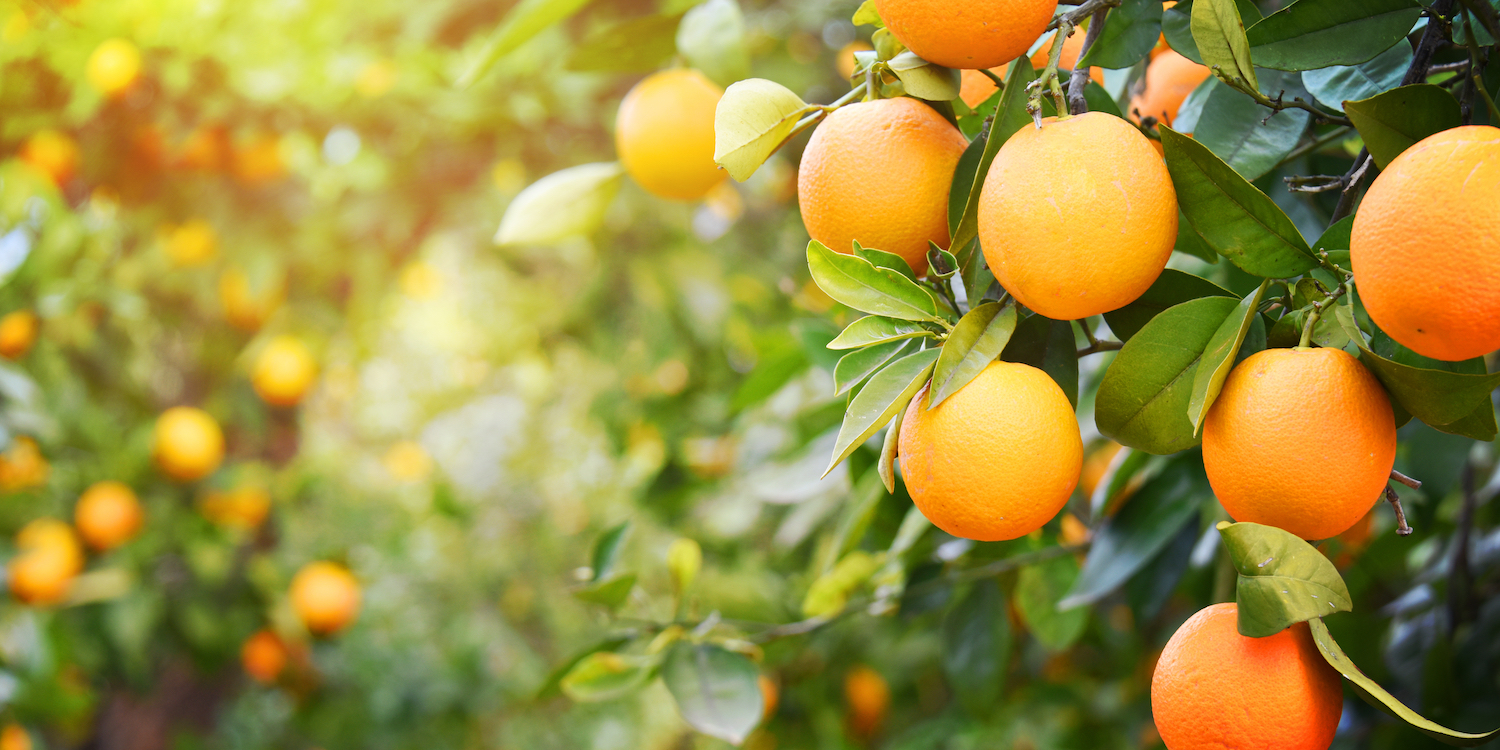Oranges: Nutrition, health benefits & risks
In addition to being a delicious snack, sweet, juicy oranges contain a multitude of nutrients.

Sweet, juicy oranges make a delicious and healthy snack or addition to a meal. A whole, medium-sized orange contains only about 60 calories and has no fat, cholesterol or sodium, according to WebMD. Oranges provide “more than 100% of the daily vitamin C requirement," said Clare Thornton-Wood, a registered dietician and British Dietetic Association (BDA) spokesperson. This can help your body to protect cells, produce collagen and absorb iron.
Indeed, oranges offer many health benefits: They may boost your immune system, give you better skin, and even help improve your heart health and cholesterol levels, according to the American Chemical Society. In addition, a 2015 review published in the journal BMC Chemistry suggests that eating citrus fruit, such as oranges, may help reduce the risk of inflammatory diseases, certain cancers and rheumatoid arthritis.
Orange juice is also packed with nutrients. However, the juice doesn't contain the fiber found in the orange pith, the white substance between the peel and the flesh. It's also easier to consume too many calories when drinking orange juice than when eating an orange, according to the U.S. Centers for Disease Control and Prevention.
Related: Citrus fruits lower women's stroke risk
Health benefits of oranges
Most citrus fruits have a good deal of vitamin C, and oranges have high levels even compared to their tangy brethren. Vitamin C, a potent antioxidant, protects cells by scavenging and neutralizing harmful free radicals, according to a 2018 review published in the journal Advances in Analytical and Pharmaceutical Chemistry.
Free radicals are reactive atoms that can form from things such as environmental pollution, cigarette smoke and stress, and exposure to a high level of free radicals may lead to chronic conditions such as cancer and heart disease.

Some research suggests that the vitamin C in oranges may be linked with a lower risk of certain cancers.
It is associated with a reduced risk of colon cancer due to preventing DNA mutations. Studies have shown that about 10-15% of colon cancers have a mutation in a gene called BRAF.
In addition, a 2013 study published in the journal Nutrition and Cancer found that the high amounts of vitamin C and folic acid, coupled with the antioxidant properties in orange juice can reduce DNA damage and, therefore, the risk of cancer.
As well as vitamin C, oranges contain fiber, potassium and choline, all of which are good for your heart. "We need to eat more (fiber)," Thornton-Wood told Live Science. Oranges are also a great source of folate and thiamine, she said, two important forms of vitamin B. Folate that helps the body lower levels of homocysteine, an amino acid that is common in red meat and is linked with poor heart health.
Potassium, an electrolyte mineral, is vital for the healthy functioning of the nervous system, and a lack of potassium can lead to arrhythmia (an irregular heartbeat), increased blood pressure and a depletion of calcium in bones, according to the U.S. National Institutes of Health.
Too much potassium, however, can lead to hyperkalemia which can be serious and life threatening and include symptoms of muscle fatigue and weakness, nausea and paralysis, according to the Mayo Clinic.
The fiber in oranges may help lower blood sugar levels in people with type 1 diabetes and improve blood sugar, lipids and insulin levels in people with type 2 diabetes. The American Diabetes Association lists oranges, along with other citrus fruits, as a "superfood" for people with diabetes.
Fiber also aids in digestion and may help lower cholesterol by blocking the absorption of cholesterol into the bloodstream, according to the Mayo Clinic.

One of the more surprising health benefits of oranges is due to their lycopene content, Thornton-Wood said. "[This is the] same antioxidant as in tomatoes and is really important for eye health," she said.
The characteristic flavor of an orange "comes from the combination of a large number of volatile compounds such as limonene combined with sugars and acids also present in the orange," Thornton-Wood said. "Overall flavor is dependent on ripeness and how the orange has been stored."
When it comes to comparing different orange types, the "main differences are related to the sweetness and therefore the sugar content," she said.
Thornton-Wood said that blood oranges are higher in anthocyanins than navel oranges, due to the red pigmentation in the blood orange. These pigments provide blood oranges with their bright red color and serve as antioxidants in the body, according to WebMD.
Are there any risks?
Oranges are great for you, but you should enjoy them in moderation, Thornton-Wood said. Eating in large quantities "could give you gastrointestinal symptoms if you are sensitive to the high fiber content, so [it's] best to have no more than one a day," she said. "Some people find it exacerbates reflux so avoid [eating oranges] at night if this is the case."
It is possible to consume too much vitamin C (more than 2,000 milligrams a day); an excess of this nutrient may lead to diarrhea, nausea, vomiting, heartburn, bloating or cramps, headaches and insomnia, according to the Mayo Clinic.
People who are taking beta-blockers (a type of medication used to treat high blood pressure) should be careful not to consume too many fruits that are high in potassium, such as oranges and bananas, according to the American Heart Association. These medicines increase potassium levels and, if mixed with large amounts of potassium-rich foods, can lead to an excess of potassium in the body. This is a significant concern for people whose kidneys are not fully functional, as the additional potassium will not be effectively removed from the body.
Should you eat the orange peel?

Orange peels are not poisonous, and as many cooks know, orange zest can pack a big flavor punch. But although orange peels are edible, they are not nearly as sweet or as juicy as the pulp. They can also be difficult to digest, and unless you're eating a peel from an organic orange, it could be covered in chemicals.
If you do eat the peel, you'll get a good amount of nutrients. "The peel actually contains more fibre and Vitamin C than the flesh of the fruit," Thornton-Wood said. "It also contains the polyphenols which are linked to prevention of many chronic diseases such as diabetes."
According to Thornton-Wood, extra precautions should be made if you want to eat an orange’s peel. "Always wash well first in hot water to remove any pesticide residue and only consume small quantities as they can be hard to digest," she said.
Flavonoids are also present in the peel. These compounds are found in many foods, such as fruits and vegetables, grains, tea and wine and are known to lower blood pressure and reduce inflammation, according to a 2016 article published in the Journal of Nutritional Science.
Additionally, orange peels contain calcium, several B vitamins, and vitamins A and C. You can get the same nutrients by eating the inner part of the peel and leaving the tough outer part.
Additional resources
- Browse the U.S. Department of Agriculture's (USDA) National Nutrient Database to find the nutrient content of thousands of foods.
- More helpful resources on oranges from the USDA.
This article is for informational purposes only, and is not meant to offer medical advice.
Sign up for the Live Science daily newsletter now
Get the world’s most fascinating discoveries delivered straight to your inbox.
Jessie Szalay is a contributing writer to FSR Magazine. Prior to writing for Live Science, she was an editor at Living Social. She holds an MFA in nonfiction writing from George Mason University and a bachelor's degree in sociology from Kenyon College.










